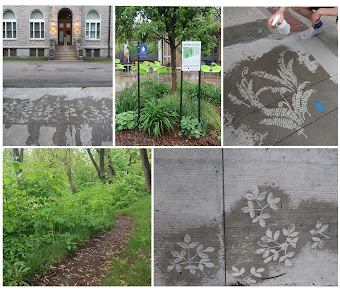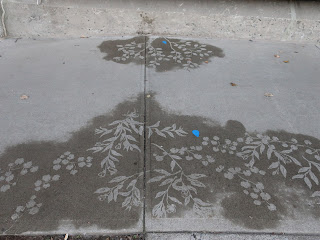In Search of the Papineau Woods
SUR LES TRACES DU BOISÉ PAPINEAU
1822-2022

Inspired by the Papineau Woods which once existed on the present-day site of Park Lafontaine in Montreal, this site-specific art installation follows the steps of Fernando Holmes, a doctor and botanist who collected a large number of plants in this woods during the summers of 1821 and 1822.
From May to October, 2022, visiters to Park Lafontaine can discover images of plants that grew in this woods two centuries earlier. At ground level on cement sidewalks, plant images become visible when it rains or when water is added to the sites by viewers. The images disappear when dry and reappear when wet. This public artwork will evolve over the summer, forming a kind of slow performance between the installation, viewers, and the ever changing landscape of the park.
Visiters are invited to bring water bottles or plant spritzers that can be filled at park water-fountains. Blue waterdrop symbols and maps indicate the sites where the botanical images are hidden in the park.
Inspirée par
l'ancien boisé Papineau, dont le territoire correspondait à
l'actuelle partie est du parc La Fontaine, à Montréal, cette œuvre d’installation
suit les pas du botaniste et docteur Fernando Holmes qui, au
cours des étés 1821 et 1822, y avait recueilli de nombreuses
plantes.
De mai à octobre 2022,
les visiteurs du parc La Fontaine pourront découvrir des images des plantes qui
poussaient dans ce boisé il y a deux siècles. Au niveau du sol, sur
les chemins bétonnés, des figures végétales se révéleront lorsqu’il pleuvra ou
lorsque les visiteurs y verseront de l’eau. Les figures
disparaîtront en séchant et réapparaîtront avec la pluie. Cette oeuvre publique évoluera tout au long de l'été, formant une sorte de performance au ralenti mettant en relation l'instalation, le public, et le paysage en constante transformation du parc.
Les visiteurs
sont invités à apporter des bouteilles d’eau ou des vaporisateurs et à chercher
les symboles de gouttes d'eau bleues indiquant l'emplacement des
images botaniques cachées dans le parc.
ostrich fern / Matteuccie fougière à l'autruche
sensitive fern / Onoclée sensible
mad woman's milk / Euphorbe heliscopique
















































